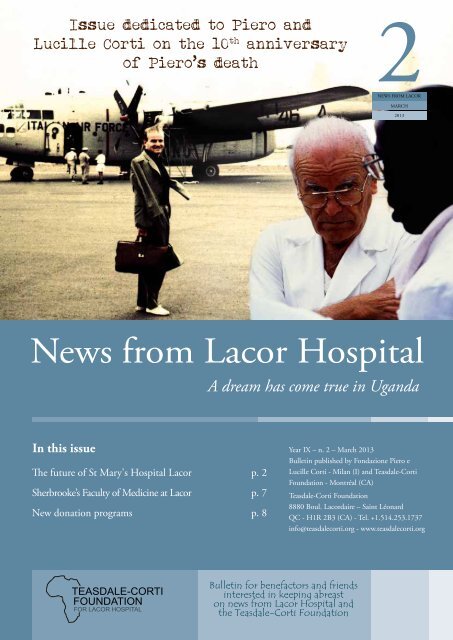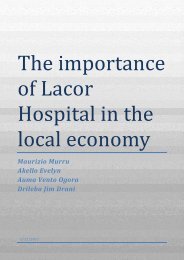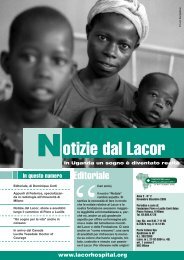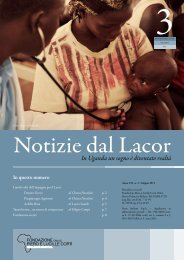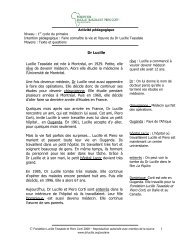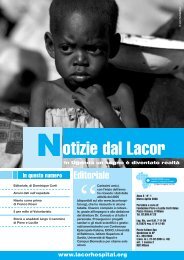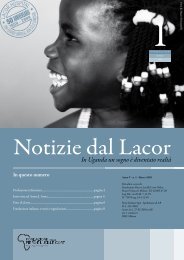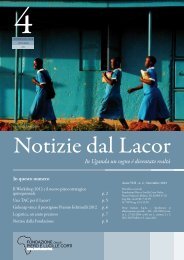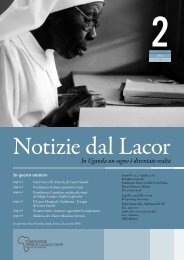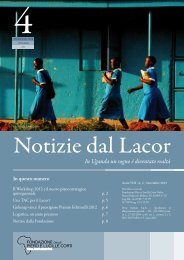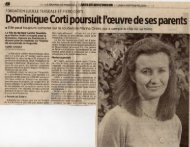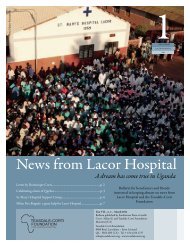News from Lacor Hospital - Fondazione Corti
News from Lacor Hospital - Fondazione Corti
News from Lacor Hospital - Fondazione Corti
You also want an ePaper? Increase the reach of your titles
YUMPU automatically turns print PDFs into web optimized ePapers that Google loves.
Issue dedicated to Piero and<br />
Lucille <strong>Corti</strong> on the 10 th anniversary<br />
of Piero’s death<br />
2<br />
NEWS FROM LACOR<br />
MARCH<br />
2013<br />
<strong>News</strong> <strong>from</strong> <strong>Lacor</strong> <strong>Hospital</strong><br />
A dream has come true in Uganda<br />
In this issue<br />
The future of St Mary's <strong>Hospital</strong> <strong>Lacor</strong> p. 2<br />
Sherbrooke’s Faculty of Medicine at <strong>Lacor</strong> p. 7<br />
New donation programs p. 8<br />
Year IX – n. 2 – March 2013<br />
Bulletin published by <strong>Fondazione</strong> Piero e<br />
Lucille <strong>Corti</strong> - Milan (I) and Teasdale-<strong>Corti</strong><br />
Foundation - Montréal (CA)<br />
Teasdale-<strong>Corti</strong> Foundation<br />
8880 Boul. <strong>Lacor</strong>daire – Saint Léonard<br />
QC - H1R 2B3 (CA) - Tel. +1.514.253.1737<br />
info@teasdalecorti.org - www.teasdalecorti.org<br />
TEASDALE-CORTI<br />
FOUNDATION<br />
FOR LACOR HOSPITAL<br />
Bulletin for benefactors and friends<br />
interested in keeping abreast<br />
on news <strong>from</strong> <strong>Lacor</strong> <strong>Hospital</strong> and<br />
the Teasdale-<strong>Corti</strong> Foundation
The future of St Mary's <strong>Hospital</strong> <strong>Lacor</strong><br />
Gulu, July 1992, letter <strong>from</strong> Piero and Lucille <strong>Corti</strong><br />
Dear friends and supporters,<br />
On April 20th, it will be ten years since my father passed away, on Easter Sunday 2003. Seven years had passed since my<br />
mother’s death; she contracted AIDS in the seventies, during a surgical procedure.<br />
Since then, the <strong>Hospital</strong> that had become their whole life, has continued operating and developing, thanks to the work, the<br />
support and the trust of the many who contributed to making it into what it is. In 1992, thirty years after their arrival at <strong>Lacor</strong>,<br />
my parents were preparing the ground for the Italian and Canadian Foundations which, they hoped, would ensure a future<br />
for <strong>Lacor</strong> even after their death. It is exciting, for all of us who work for the foundations, to read mum and dad’s original<br />
text with handwritten notes in the margins, with which they announced the foundations' registration to friends, family and<br />
benefactors.<br />
We thought of sharing this document with you because, although we had to shorten it and insert some explanatory notes, it<br />
illustrates the founding values of their work, the steps they took, the work they managed to accomplish and the hopes they<br />
had for the Foundation and for the future of their, and of our, <strong>Lacor</strong>.<br />
<strong>Lacor</strong> continues serving the local population and is a reference point for the entire northern Uganda.<br />
The Foundations have grown and offer a crucial financial support and much more, as we have attempted to illustrate in our<br />
past newsletters.<br />
We beg our readers and all those to whom we owe so much for the support given us, to read between the lines and understand<br />
the spirit that powered the dream and transformed it into today’s reality, with the commitment to ensure its future.<br />
Dominique <strong>Corti</strong><br />
Kind friends and readers,<br />
We have decided to write the introduction to this document<br />
ourselves, with the aim of convincing you to<br />
participate. Participate in what? In the future, by<br />
changing it.<br />
In fact, Lucille and I are convinced, and we are not<br />
alone in believing this, that <strong>Lacor</strong>’s future in the<br />
years to come, should be your task as well as ours.<br />
The survival of the <strong>Hospital</strong> as it is today is in jeopardy.<br />
It is the only hospital that carries out “real”<br />
hospital activities in the Gulu district, which has<br />
360,000 inhabitants, but patients come <strong>from</strong> all over<br />
the country. It is also the referral point for the<br />
hospitals of northern Uganda. It is known as the best<br />
<strong>Hospital</strong> in Uganda, and, even if it is a private institution,<br />
it offers its services at a cost that is accessible<br />
to everyone.<br />
The aim of these few pages is the hope that the words,<br />
pictures and numbers will lead the readers to commit<br />
for the <strong>Hospital</strong>’s future. And it is on this commitment<br />
that the future of <strong>Lacor</strong> <strong>Hospital</strong> depends.<br />
FIRST EVENTS<br />
We will start winning your trust by shortly introducing<br />
you to <strong>Lacor</strong>’s history.<br />
The construction of the <strong>Hospital</strong> was started in 1958<br />
by Mgr. Cesana, Bishop of Gulu and by the Comboni Mis-<br />
242<br />
sionaries who were active in northern Uganda <strong>from</strong><br />
the start of the century. Two hospitals had already<br />
been opened by the missionaries in an area of 120,000<br />
square km and with almost 2,000,000 inhabitants. Four<br />
others were opened within a few years.<br />
Lucille and I arrived here in May 1961. By then, the<br />
maternity ward, the outpatient department and a few<br />
beds managed by four Comboni sisters had been functioning<br />
for a year.<br />
From the start, the Bishop granted the <strong>Hospital</strong> an independent<br />
administration, which included Lucille and I.<br />
In return we had taken on, with joyful innocence, the<br />
commitment to finding the funds to complete the <strong>Hospital</strong><br />
and for its future development, in addition to<br />
squaring the balance sheet. We probably wanted to<br />
avoid delays and hitches in the realization of the<br />
ideal which brought us to Africa: “to create a professionally<br />
efficient hospital, but accessible to the<br />
needy and the poor”.<br />
Lucille and I were alone for nearly 5 years. From 1965,<br />
CUAMM of Padova (the first Italian non government<br />
medical organization and to date, as far as we know,<br />
the most comprehensive one) started sending 3 or 4<br />
volunteer doctors every two years for twenty years.<br />
Subsequent Italian laws on volunteers and civil service<br />
in substitution of compulsory military service<br />
facilitated the employment of these volunteer doctors<br />
by paying their journey, insurance and a modest sal-
ary. This was a big step forward, not only for us, but<br />
for all the seven missionary hospitals, and for some<br />
Ugandan government hospitals that, assisted and organized<br />
by the CUAMM projects, could finally develop<br />
and improve the quantity and quality of their work.<br />
At this point it is impossible for us to go further<br />
without mentioning at least a few of the many doctors<br />
who arrived at Gulu: Prof. Dalla Bernardina, Bolognesi,<br />
Busato, Rho, Stefanini, Molinari, Prof. Warley, Dr. Desjardins<br />
<strong>from</strong> Canada and Prof. Parson <strong>from</strong> the United<br />
States. All of them shared their great competences and<br />
qualities. Of course, these few words does them no justice;<br />
we are sorry and secretly ashamed because it is<br />
not fair to speak only about Piero and Lucille.<br />
In 1972, we opened the school for professional nurses<br />
with 90 students for the three year course, and<br />
three peripheral health centres in Opit, Amuru and<br />
Pabo within 45 km <strong>from</strong> Gulu. In 1981, we started the<br />
training of health educators and opened the school<br />
for laboratory technicians.<br />
ECONOMIC HELP<br />
At first we searched for “benefactors” exclusively<br />
among family, friends and “friends of relatives and of<br />
friends”. From ’68 to ’84, the major donors were Catholic<br />
non-government organizations (NGOs) such as Misereor<br />
(Germany), Peace and Development with Fame-Pereo, the<br />
Roncalli Foundation, Oxfam, Oeuvre du Cardinal Léger<br />
(Canada), Mani Tese (Italy).<br />
While the <strong>Hospital</strong> developed, the economic, political<br />
and social conditions in Uganda were undergoing dramatic<br />
changes. In 1971, with the arrival on the scene of<br />
Idi Amin, things began to fall apart even faster and<br />
reached an unimaginable decay, and continued <strong>from</strong> ’79<br />
until ’85 with the second Obote period.<br />
These long years of atrocities and devastations in<br />
every aspect of social life produced extreme poverty<br />
and many deaths caused by violence, lack of medical<br />
assistance, hunger and a lot of child malnutrition<br />
for the almost 2 million people in northern Uganda.<br />
Our <strong>Hospital</strong> too has lived through very dramatic periods.<br />
Many among the readers will ask themselves<br />
how <strong>Lacor</strong> could keep increasing both facilities and<br />
output, despite the harsh conditions in which it operated:<br />
economic decline, wars, dictatorships, rebellions,<br />
destructions, the fear that weighed on everyone,<br />
the difficulty in getting supplies, all should have<br />
pushed us to give up and leave. Why did we stay? It is<br />
true that difficulties are a challenge. At <strong>Lacor</strong> it is<br />
a duty to believe in Providence, to keep a firm hold on<br />
optimism and never give up!<br />
A solution for all of these difficulties was the Support<br />
Group in Italy, which has offered logistic and administrative<br />
support and even more, for years. It has<br />
raised funds, purchased and sent equipment, medicines,<br />
construction materials, food and almost anything the<br />
<strong>Hospital</strong> needed in order to function through three or<br />
four containers and air shipments to <strong>Lacor</strong> each year.<br />
3
Until now, the group has been nearly exclusively a<br />
family association, led initially by my father Mario<br />
and my sister-in-law Vanda. They purchase medicines,<br />
tools, etc. and send them <strong>from</strong> the family’s textile company,<br />
Manifattura <strong>Corti</strong>. One of my brothers, Eugenio<br />
<strong>Corti</strong>, is now President of the Group, our nephew Mario<br />
Vismara is Vice-President and Mario Botteon in Besana<br />
has offered his precious accounting services. Others,<br />
such as Dr. Morelli, my nephews, brothers and sisters,<br />
our daughter Dominique, as well as friends and benefactors,<br />
have given their time and/or money to the <strong>Hospital</strong>.<br />
Basically, my nephew Mario Vismara is the soul<br />
and keystone of the Group, even using the family company<br />
as a hub for gathering and shipping everthing.<br />
Since 2012, after the closing of Mario Vismara’s company,<br />
the <strong>Hospital</strong>’s “Support Group” is hosted by the Manifattura<br />
<strong>Corti</strong>, just as it was in the beginning. It is now directed by<br />
another Mario <strong>Corti</strong>, one of Piero’s nephews. .<br />
All these benefactors, along with all those who worked<br />
at the <strong>Hospital</strong>, have represented a sort of personification<br />
of Providence for <strong>Lacor</strong>.<br />
Gradually, <strong>from</strong> ’75 onward, health services in Uganda<br />
were offered almost exclusively by the missionary<br />
hospitals. This pushed us to aggressively develop <strong>Lacor</strong><br />
<strong>Hospital</strong> services in order to answer as best as<br />
possible to the increasing needs of the population.<br />
These hospitals, now known as Catholic not for profit hospitals,<br />
still carry out approximately 40% of the health care<br />
activities in Uganda.<br />
THE AFRICANISATION PROCESS<br />
In ‘82 the <strong>Hospital</strong> was approved for the internship of<br />
newly graduated Ugandan doctors <strong>from</strong> Mulago University<br />
in Kampala. After various unsuccessful attempts,<br />
we were convinced that we should intervene directly<br />
in the process of professional training of Ugandan<br />
physicians if we wanted to convince them to work with<br />
us and to get to know each other…<br />
In ‘84 the first Italian/Ugandan technical cooperation<br />
project started; it was supervised directly by the<br />
Italian Ministry of Foreign Affairs and was aimed at<br />
putting <strong>Lacor</strong> hospital in the condition to train each<br />
year 4-6 Ugandan medical interns and of obtaining the<br />
authorisation <strong>from</strong> the Ugandan Ministry of Health to<br />
work in our missionary hospitals once they had completed<br />
their internship.<br />
Accepting and carrying out the Italian Cooperation<br />
project for us was a dream come true, because it gave<br />
us, in just a few years, resources and qualified personnel<br />
that we did not expect to have before 2000.<br />
LACOR HOSPITAL TODAY<br />
Summarizing <strong>Lacor</strong> <strong>Hospital</strong> in just a few numbers today,<br />
July ‘92, can help understand it a little more.<br />
Number of beds: 450, including 90 in the almost completed<br />
tuberculosis ward: the spread of the AIDS Virus (at<br />
least 15% of the population in Gulu district has AIDS)<br />
has multiplied the number of patients with active tuberculosis<br />
by 10, making this ward a priority.<br />
Doctors: 16 Ugandan, of which 3 specialists, 4 medical<br />
officers and 9 interns.<br />
Lucille and I are the only white doctors remaining.<br />
Foreign specialists/experts are present on short missions<br />
when we request <strong>from</strong> the Italian Ministry of<br />
Foreign Affairs for the training of Ugandan doctors.<br />
<strong>Hospital</strong> activity in the year 1/7/91 to 30/6/92: we admitted<br />
11,595 patients (of which 4,869 children); and 104,240<br />
patients were treated as out-patients; 1,200 major operations<br />
and 2,636 minor operations were carried out,<br />
there were726 deliveries, 9,188 antenatal examinations,<br />
14,620 radiological and 3,120 ultrasound examinations;<br />
248 endoscopies, 952 biopsies…<br />
This is exclusively the <strong>Hospital</strong> activity, because the<br />
three peripheral health centres of Opit, Amuru and<br />
Pabo were raided and have not been active since ’86.<br />
By comparison the activities of the <strong>Hospital</strong> alone in the<br />
year 2011/12, illustrated in this year’s first newsletter show<br />
that the total number of doctors and interns has doubled,<br />
the number of patients admitted and treated at the out patient<br />
department has doubled (this number does not include<br />
the patients treated in the now active peripheral health<br />
centres, which represent 30% of all <strong>Lacor</strong> patients), the<br />
numbers of major operations have increased by four, the<br />
deliveries by five, the number of ultrasound examinations<br />
by almost ten times.<br />
Since January 1991, <strong>Lacor</strong> <strong>Hospital</strong> is engaged with the<br />
government health personnel in a vast program of primary<br />
health care in the entire Gulu district.<br />
When peace prevailed in nearly all of Uganda <strong>from</strong> the<br />
early ‘90s (with the exception of the north), the Ugandan<br />
Government, strongly supported by international aid, tried<br />
to reconstruct the health sector, which however is still very<br />
poor especially in the rural areas. Since the second half of<br />
the ‘90s, the government invited the former mission hospitals<br />
to share the national health strategy and in turn subsidizes<br />
them. In spite of the inevitable difficulties, the public<br />
– private partnership continues: the subsidy, or Government<br />
of Uganda delegated funds, covered 8% of <strong>Lacor</strong>’s<br />
operating costs last year. In 2003, the government founded<br />
the country’s third faculty of medicine (the only one in the<br />
north), of which <strong>Lacor</strong> as a university teaching site.<br />
It must be pointed out that all the “common” patients who<br />
are admitted (95% of the total) pay a 4 to 6 dollar fee,<br />
everything included. Food is provided and prepared by<br />
the relatives. For children under 6 any kind of treat-<br />
4
Left: 1993, <strong>from</strong> left to right, Dr. Bruno Corrado, Dr. Matthew Lukwiya, Brother Elio Croce, Valeria Corrado, Dr. Piero <strong>Corti</strong>,<br />
Dr. Lucille Teasdale, Sister Lina Soso, Lise Teasdale. Right: Piero talks to the traditional birth attendants in a village.<br />
ment, either outpatient or admission, is free of charge.<br />
Today, as for the past seven years, the <strong>Hospital</strong> has depended<br />
financially mostly on Italian Government aid.<br />
The total income <strong>from</strong> patients covers, more or less, 20-<br />
25% of the recurrent costs, which were 270,000,000 Ugandan<br />
shillings in 1991. This sum includes medicines we<br />
buy in Uganda, current material and salaries.<br />
Not even a future upturn of northern Uganda’s economy<br />
would solve the problem because, naturally, salaries<br />
and other costs would increase as well. Before the<br />
increasingly difficult economic situation in Italy<br />
forces the government to discontinue all the Ugandan<br />
projects, we believe it is both necessary and urgent<br />
to come up with something new, which we must “own”<br />
completely and must be focused on <strong>Lacor</strong> <strong>Hospital</strong>’s<br />
reality and needs. Something that can help cover the<br />
running costs every year. Lucille and I have been oppressed<br />
by this issue for the last couple of years and,<br />
now that most of the old duties have been passed on<br />
to the Uganda doctors, we believe that this has become<br />
our most important duty towards the <strong>Hospital</strong>.<br />
Since the late ’90s, with the escalation of the civil conflict in<br />
northern Uganda, and the reduction of aid <strong>from</strong> the Italian<br />
government, the <strong>Hospital</strong> relies mostly on aid <strong>from</strong> organisations<br />
such as the Italian Episcopal Conference, ECHO (the European<br />
Community Humanitarian Office), the Austrian and<br />
Danish government aid, Terre Des Hommes-Holland, USAID.<br />
WHAT FUTURE? THE FOUNDATIONS<br />
Today we are convinced, together with our collaborators,<br />
that the answer is to create an Italian and a<br />
Canadian foundation. The initial steps have already<br />
been taken: a first draft of the articles of incorporation<br />
have been filled out with Mr. Botteon and Mr.<br />
Enrico Citterio, and have been presented to the Notary<br />
Mr. Giuseppe Gallizia <strong>from</strong> Milan. Some points remain<br />
to be specified during the next meetings with the Notary,<br />
then the long and complicated legal recognition<br />
procedure will start.<br />
In practical terms, establishing the Italian Foundation<br />
implies putting together, in a few years, a capital<br />
that will yield sufficient interest to cover the<br />
<strong>Hospital</strong>’s annual running costs.. But it also implies<br />
the capacity of exercising, thanks to these funds, a<br />
fundamental task of control, so that <strong>Lacor</strong> <strong>Hospital</strong>’s<br />
strategy and activities continue in the same direction<br />
without coming to an end as has happened to<br />
many other missionary hospitals and institutions in<br />
developing countries.<br />
In the <strong>Hospital</strong>’s future – as Lucille and I see itthe<br />
Foundations and the Support Group should act<br />
as a sort of “umbilical cord”: if it were to be cut,<br />
everything and everyone would be severely penalized!<br />
Thus intended, the Foundations and the Support Group<br />
would realize everyone’s expectations: that <strong>Lacor</strong> <strong>Hospital</strong><br />
should continue, even when it will be completely<br />
in Ugandan hands, to function without stopping or<br />
losing efficiency and remaining true to its fundamental<br />
duty, to help mostly the needy and the poor.<br />
If you too, friends and readers, can believe in this<br />
possibility, the present document’s message is an explicit<br />
invitation to participate in the Group’s activities<br />
and in the Foundations' success.<br />
The present Bishop of Gulu, Mgr. Martin Luluga, completely<br />
agrees with the program outlined above, and<br />
also agrees with the people chosen to direct the <strong>Hospital</strong><br />
in the future. He too is convinced that without<br />
adequate and permanent financial security that would<br />
allow these people to lead the <strong>Hospital</strong>, all of this<br />
would break down just like everything else.<br />
Among these people, Dr. Matthew Lukwiya (who has been<br />
The current President of the Board of Governors of <strong>Lacor</strong><br />
<strong>Hospital</strong>, Archbishop John Baptist Odama, who succeeded<br />
Mgr. Luluga in 2000, has approved the program made by<br />
Piero at the time and went further by granting the <strong>Hospital</strong><br />
a legal personality. He has been a steadfast defender of<br />
the <strong>Hospital</strong>’s mission in favour of the poor, the needy and<br />
“ngini-ngini” (the smallest ants of all).<br />
5
working with us at <strong>Lacor</strong> for nine years and has been<br />
Deputy Medical Director for the last two years) is, for<br />
all of us, the best guarantee for the future: we do<br />
not hesitate to define him as “an outstanding doctor<br />
and person”. Even the Comboni missionaries expressed<br />
themselves positively when we discussed these issues<br />
with them, and we are hopeful that the support they<br />
have constantly given to <strong>Lacor</strong> <strong>Hospital</strong> will continue<br />
unswervingly in the future.<br />
Dr. Matthew Lukwiya, Medical Director of <strong>Lacor</strong>, not only<br />
proved to be an extraordinary doctor and person, he also<br />
spearheaded the fight for the containment of the terrible<br />
Ebola haemorrhagic fever in 2000 (a lethal outbreak that<br />
spread in north Uganda and that he had personally identified).<br />
He set up an isolation ward and led one hundred<br />
members of the <strong>Hospital</strong>’s staff who volunteered to risk<br />
their lives daily in caring for the sick in the isolation ward<br />
and to bury the dead. He, along with 12 other of <strong>Lacor</strong>’s<br />
staff died after having contracted the disease while fulfilling<br />
their duty, thereby giving proof of exceptional heroism<br />
and dedication.<br />
We would like to conclude with some considerations<br />
made by my brother, Rev. Corrado, a Jesuit missionary<br />
priest in Chad. In a letter to us last December after a<br />
visit to Gulu he writes:<br />
"It is good to realize how much work has been done and continues<br />
to be done. Every year, at <strong>Lacor</strong>, thousands of people<br />
find a place where they can look to their future with a little<br />
hope. Even the ones who will not recover their health, will have<br />
found that, in this world, there are people who care about<br />
them and their terrible problems, and who can help solve them<br />
in some measure. How many have been to <strong>Lacor</strong> and have<br />
drawn a benefit <strong>from</strong> it... the amount of work that has been<br />
done is considerable. But<br />
so too is the work laid out<br />
for the future, thanks to the<br />
structures that have been<br />
realized and the human resources<br />
that have been involved,<br />
trained, motivated<br />
and sustained in one complex<br />
and huge project. For<br />
all those who live close and<br />
even far away, <strong>Lacor</strong> <strong>Hospital</strong><br />
is a reference point allowing<br />
them to look at their own condition<br />
with some hope and not<br />
only darkness.<br />
There is another aspect that<br />
gives importance to this<br />
46<br />
As Piero had correctly foreseen, the improvement of economic<br />
and social conditions in the country since the ’90s<br />
determined an increase in costs, with a harder impact in<br />
the north where war was still raging and preventing any<br />
kind of development. The Italian Foundation, recognized by<br />
the Italian Ministry of Foreign Affairs in 1995, has grown to<br />
be the major supporter of the <strong>Hospital</strong> particularly during<br />
the period in which most emergency humanitarian organizations<br />
abruptly withdrew their help following the end of<br />
the conflict in the north in 2007. Moreover, the decrease in<br />
bank interest rates had made it impossible to accumulate<br />
enough capital to ensure covering the <strong>Hospital</strong>’s running<br />
costs with the interest.<br />
For the last two years, the Italian Foundation has sent all the<br />
funds collected during each year and has had to draw on<br />
the emergency funds that were set aside in the past thanks<br />
to specific donations for this purpose.<br />
In addition to raising funds and obtaining the necessary<br />
equipments, the Foundations have an important role in<br />
seeking those competences that are needed in order to<br />
manage a complex system such as the <strong>Hospital</strong>, when<br />
they cannot be found locally. In previous editions of this<br />
newsletter, that you can consult at www.teasdalecorti.org<br />
/newsletter, we highlighted several such projects as the<br />
reorganisation of the pharmacy, human resources, IT and<br />
management, launched at the request of the <strong>Hospital</strong> Management,<br />
along with the shipment of medication thanks to<br />
the Canadian Foundation.<br />
complex reality that is St. Mary's <strong>Hospital</strong> <strong>Lacor</strong>. It is a<br />
social reality, it is an organisation that functions and is officially<br />
recognised. Outside <strong>Lacor</strong>, everything seems to be nonexistent,<br />
corrupted or not functioning well. In such a scenario,<br />
a complex like <strong>Lacor</strong> <strong>Hospital</strong> is a symbol of hope, a positive<br />
factor that can stimulate recovery and restructuring just by<br />
being there."<br />
(The “reproducible model”<br />
is a fixed idea of<br />
ours’ for the past 30<br />
years – Piero & Lucille).<br />
"Finally, <strong>Lacor</strong> allows us<br />
to perceive a certain role<br />
of the church, and of<br />
what it should be its essence…<br />
it is difficult to<br />
judge who is and who is<br />
not perfect... But where<br />
there is a small light, let<br />
us care for it and give<br />
that light space so that it<br />
can shine brighter."<br />
Piero and Lucille
Sherbrooke’s Faculty of Medicine at <strong>Lacor</strong><br />
I already visited St. Mary’s <strong>Hospital</strong> <strong>Lacor</strong> in 2007.<br />
Together with my spouse, we were sent to evaluate the<br />
hospital for a Quebec charitable foundation. It was a<br />
special visit, because we were going to Lucille Teasdale’s<br />
hospital and Lucille is my hero and role model.<br />
As we were familiar with health care in Africa, we were<br />
able to take a critical and unbiased look. We were impressed<br />
by the quality of the care provided and the<br />
efficiency of the organization. “One day I'll definitely<br />
come back,” I told myself.<br />
I am a physician and professor at the Department of<br />
family medicine at Université de Sherbrooke, and a<br />
co-director of an international health internship program<br />
and a training program for health professionals<br />
in Mali. As we could not send interns to Mali this year<br />
because of the political, social and military situation<br />
in the West African country, we turned to St. Mary’s<br />
<strong>Hospital</strong> <strong>Lacor</strong> in Northern Uganda instead.<br />
Our team consisted of a resident physician Roxanne<br />
Gagné, a graduate nurse Marilyn Prévost, an experienced<br />
family physician Dominique Mercier and me, François<br />
Couturier, as the internship supervisor. We stayed for<br />
four weeks, <strong>from</strong> November 18 to December 15, 2012.<br />
We first stayed at the hospital for about ten days to<br />
get to know the people and become familiar with the<br />
resources, diseases and history of the country, the region<br />
and the <strong>Hospital</strong>. Here are a few excerpts <strong>from</strong><br />
our collective diary:<br />
pI was also impressed by the size of the hospital, which<br />
includes more or less 425 beds, 6 operating rooms, recovery<br />
room, severe burns unit, specialized outpatient clinics:<br />
pediatrics, HIV, oncology, physiotherapy room, as well as<br />
pathology, microbiology, hematology and biochemistry<br />
laboratories.<br />
p Both of them are in their mid-twenties and she is newly<br />
pregnant. They have just learnt that they are both HIV-positive.<br />
New information, discussions, the start of a triple<br />
therapy for her, in order to achieve undetectable viral load<br />
to protect the baby. They are calm and dignified and even<br />
under such shock, they look like they are in love.<br />
Then we travelled to the peripheral health centre in<br />
Pabbo, an hour drive <strong>from</strong> the <strong>Hospital</strong>. There we<br />
could really offer the best of ourselves as a nurse and<br />
family physicians.<br />
We were welcomed by the clinician Benedict Otii, midwives<br />
Rose and Gloria, Sister Joyce, a nurse, nursing<br />
aides and two lab assistants. We lived on site and shared<br />
the basic living conditions and the heavy workload, took<br />
care of adults and children, and delivered babies.<br />
p I’m still entrenched in the Quebec health care mentality.<br />
At times, I very much doubt my skills. The diseases and the<br />
medication available are only understood to a certain point<br />
and this makes it difficult for us to adapt. I think we would all<br />
like to become efficient more quickly. We tend to forget that<br />
it takes weeks, or even moths, to become at ease in a new<br />
environment, be it here or back home. We are not here to<br />
change the world, but to try to build a lasting partnership and<br />
share our knowledge.<br />
p Today is my birthday. After lunch, my colleagues surprised<br />
me with a present packed in a box of crackers.<br />
Dominique <strong>Corti</strong> went out of her way and managed to<br />
order a nurse’s cap after getting the <strong>Lacor</strong> head nurse’s<br />
permission. I’m all pretty with the lace cap on my head.<br />
p The patients are afraid of the doctor and seem to fear<br />
the imminent violence that physical contact represents.<br />
They look completely destitute. I strongly suspect that<br />
they suffer <strong>from</strong> collective post-traumatic stress disorder.<br />
Twenty-six years of terror and atrocities committed on the<br />
most vulnerable parts of the civilian population inevitably<br />
leave some marks.<br />
p It’s the end of a wonderful adventure. Pabbo was an<br />
amazing place for an internship.<br />
p Whether it was the fatigue or the nostalgia, nobody<br />
spoke during our return journey. I was watching the landscape<br />
out of the window, perhaps for the last time.<br />
p It will definitely take some time to fully realize the impact<br />
of what I’ve learnt; as I have no doubt that this experience<br />
will make a difference, even for practising at home.<br />
We would like to thank all those who welcomed us so<br />
warmly, both at the hospital and at the centre in Pabbo.<br />
Links have been forged and our world has expanded.<br />
François Couturier<br />
Left to right: Benedict Otii, Marilyn Prévost, Dominique<br />
Mercier, François Couturier, midwife Rose, Roxane Gagné.<br />
7
New donation programs<br />
After the context changes brought by peace and security, and after the approval of the new 2012-<br />
2017 <strong>Hospital</strong> Strategic Plan last June, the Foundation has decided to adapt its donation programs so<br />
that they become more relevant to the <strong>Hospital</strong>’s needs. Three new possibilities of helping the <strong>Hospital</strong><br />
and the people who seek treatment at the <strong>Hospital</strong>, considered as a reference point, now exist.<br />
Details for donations are as follows:<br />
1. GENERAL DONATION<br />
It remains a very important form of support because it allows us to give your help where the<br />
need is greater depending on the current necessities.<br />
2. TREAT A WOMAN<br />
By participating in this program, you will guarantee obstetric-gynaecological services, general<br />
and specialized (birth, admissions, operations, neonatal care), to <strong>Lacor</strong> patients.<br />
This program aims at reducing maternity deaths and at improving the reproductive health in a<br />
country where still 435 women die because of complications during birth out of every 100,000<br />
live births, and where 20% of pregnancies occur during adolescence.<br />
How many women do you want to help?<br />
1 woman: $ 13<br />
5 women: $ 65<br />
10 women: $ 130<br />
3. TREAT A CHILD<br />
By participating in this program, you will guarantee, to patients under 6 years, general and specialized<br />
paediatric services (clinic, admissions, surgical operations). This program is one of the objectives<br />
in the National Health Plan to reduce infant mortality and to treat the weakest category<br />
of the population.<br />
How many children do you want to help?<br />
1 child: $ 20<br />
5 children: $ 100<br />
10 children: $ 200<br />
THE TEASDALE-CORTI FOUNDATION<br />
The Teasdale-<strong>Corti</strong> Foundation is a charitable organization<br />
created to contribute to the support of the <strong>Lacor</strong> <strong>Hospital</strong><br />
in northern Uganda.<br />
Reg. N. : 890520745RR 0001<br />
DONATIONS<br />
Donations to the Teasdale-<strong>Corti</strong> Foundation can be sent<br />
by mail to:<br />
Teasdale-<strong>Corti</strong> Foundation<br />
8880, boul. <strong>Lacor</strong>daire, St-Léonard,<br />
QC, H1R 2B3 (CA)<br />
or online: www.teasdalecorti.org<br />
8<br />
CONTACT<br />
Filippo Campo - f.campo@teasdalecorti.org<br />
Tel.: +1.514.253.1737<br />
8880, boul. <strong>Lacor</strong>daire, St-Léonard, QC.<br />
H1R 2B3 (CA)<br />
TRANSLATION AND REVISION, our collaborators:<br />
Roisin Grieco, Nikol Kvasnickova<br />
NEWS FROM LACOR is a bulletin offered to all who<br />
wish to receive news on the <strong>Lacor</strong> <strong>Hospital</strong> and the Teasdale-<strong>Corti</strong><br />
Foundation. It is published by <strong>Fondazione</strong> Piero e<br />
Lucille <strong>Corti</strong> (Milan, Italy) and Teasdale-<strong>Corti</strong> Foundation<br />
(Montreal, Canada).


